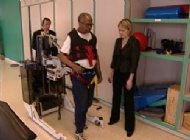 Stroke patients usually suffer from the loss of motor functions like walking independently. Chicago PT has developed KineAssist technology which is a rehabilitative robotic system that aids therapists in rehabilitative sessions. The system provides patients recovering from stroke an omnipresent safety net that catches them when they fall. This allows the therapist to improve the quality of the session by providing more realistic training scenarios instead just preventing the patient from falling over.
Stroke patients usually suffer from the loss of motor functions like walking independently. Chicago PT has developed KineAssist technology which is a rehabilitative robotic system that aids therapists in rehabilitative sessions. The system provides patients recovering from stroke an omnipresent safety net that catches them when they fall. This allows the therapist to improve the quality of the session by providing more realistic training scenarios instead just preventing the patient from falling over.
The system is able to follow the patient allowing the patient to move around freely without feeling any extra weight. The harness is the interface connecting the machine and the patient. This tracking of the patient’s motion is done by force sensors in the harness. This allows for control of the robot which reacts to the patient’s movement and also the ‘catching’ of the patient when he falls over. In this sense the system is more of a reactive agent that only reacts to external stimulus.
Another feature that stands out is that the machine can lift the patient reducing the load on the patient’s legs. This allows for progressive training which could not be achieved by past rehabilitative methods.
Voice control or a wireless remote control could be built into the system to allow the therapist control the robot’s functions without endangering the patient with excess wires.
Further applications for this technology include creating this ‘safety net’ for gym users who train alone or for athletes who challenge themselves with heavier weights.
Feng Junwei Benjamin
U046064E
Check the Chicago Link for more videos Reference: Carolina News Tech Talk Chicago PT KineAssist paper MIT review paper
6 comments:
Choo Liang Kwang U046028R
Yes, this is an interesting robot. It prevents a person undergoing rehab from hurting themselves (by not letting them fall) and I think it will also increase the morale and confidence of the person, so that he/she will be able to recover faster.
However, from the pictures and photos, it can be seen that the machine is actually quite bulky, and requires a large space to move about. Perhaps in the near future, things can be improved further...
U045926H Wong Jia Hui
KineAssist comes across as a very well-conceptualised assistive robot, especially with features to reduce the patient's load and the elimination of wires.
I think there is a future for this robot being used in many hospitals and physiotheraphy centers, not only for stroke patients, but also for anyone with walking problems (accident victims etc).
this robot seems to be very useful in countries like singapore where there is a shortage of nurses. by the introduction of these kind of robots in patient care, the nurses can be relieved of the duty of helping patients going through rehabilitation without getting hurt. in this way, the demand for nurses can be managed.
Jaseema Banu - U036882L
this robot seems to be very useful in countries like singapore where there is a shortage of nurses. by the introduction of these kind of robots in patient care, the nurses can be relieved of the duty of helping patients going through rehabilitation without getting hurt. in this way, the demand for nurses can be managed.
Hi, this robot is definitely a big help to those who are undergoing motion rehabilitation. People who are recovering from stroke or other similar sickeness that impairs their movement will find this treatment useful.
However, I have a question regarding its economic feasibility. What institutions or hospitals are presently using them? If Singapore hospitals were to use them, will it be costly? This is in light of the already high medical bills that many Singaporeans frequently complain about. Thanks. :)
Rgds,
Ng Chin Ling (U047690E)
To LiangKwang
I believe that the robot has to be of around this size to handle the bulk of most patients.
To Chin Ling
I beleve that although the initial investment in this machine will be expensive. However it is one that will provide lasting benefits for patients. Health is one thing that people value the most. I believe that although it will increase that bills but it will be worth it.
Also since it can be shared among patients and is not customised to any patient in mind, I believe that the cost can be spread out.
Feng Junwei Benjamin
U046064E
Post a Comment